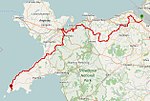Greenfield Valley Heritage Park
Country parks in WalesFarm museums in the United KingdomIndustry museums in WalesMuseums in FlintshireOpen-air museums in Wales ... and 2 more
Organisations based in FlintshireParks in Flintshire

Greenfield Valley Heritage Park (Welsh: Dyffryn Maes Glas) is a 70-acre (28 ha) country park in the United Kingdom. It is located in Greenfield, near the town of Holywell in North Wales. It is well known for its woodland, reservoirs, ancient monuments (including the ruins of Basingwerk Abbey), rich industrial past and its factories which played a part in the Industrial Revolution.
Excerpt from the Wikipedia article Greenfield Valley Heritage Park (License: CC BY-SA 3.0, Authors, Images).Greenfield Valley Heritage Park
Greenfield Road,
Geographical coordinates (GPS) Address Nearby Places Show on map
Geographical coordinates (GPS)
| Latitude | Longitude |
|---|---|
| N 53.2835 ° | E -3.2144 ° |
Address
Greenfield Road
CH8 7PZ , Holywell
Wales, United Kingdom
Open on Google Maps







